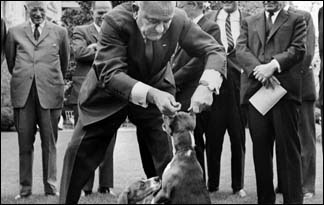Here are parts of postings from this site:--
... by rerevisionist » 23 Apr 2011 10:57
PDF of plan for thorium reactor---
[This may not be the original document moved from Internet, which was a challenge to coal and mentioned molten salt]
... the above paper online jointly authored by Ralph W Moir and Edward Teller ... [Thorium reactors] seem designed so the radioactive part is entirely underground. Above ground is the usual turbine system; heat is supplied from the subterranean reactor. The 'molten salt' seems to be sodium fluoride/ lithium fluoride/ beryllium fluoride or some mixture; I haven't checked, but their melting point I'd assume must be quite a lot below ordinary salt, sodium chloride. There's some mention of thallium, an extremely poisonous element, as is beryllium. For that matter, fluorides are too.
I do hope the Chinese show some independence and check this out very carefully indeed. If these things are supposed to only produce a fraction of China's energy, they are ideal for a pretence of generation, since they could be supplied underground undetectably.
They are also ideal as another form of dump - to dispose of poisons underground. I suspect China is accumulating difficult effluents. The top of the structures is 10 metres below ground; it's not clear how far down the thing would go, but it would be simple enough to include a lot of hidden space below it. ...
From a 'Pugwash' 'report' dated 2000---
http://www.pugwash.org/reports/nw/nw8b.htm
[...]
The workshop discussed nuclear waste storage on the Kola peninsula, where feasibility studies have been done for granite repositories at depths of 150 to 200 meters, estimated to cost 200 million Euro. Locations on Novaya Zemlya are not feasible, both because of sandstone/ limestone strata and because global warming increases of eight degrees celsius could cause the repository to slide into the sea.
[...]
IN 1946-47 following the end of World War II, an estimated 300,000 tons of German chemical weapons (mustard, phosgene, prussic acid, sarin) were confiscated and sunk in the Baltic and North seas. The Soviet Union disposed of such weapons, loaded on ships, in the Baltic, while the US and Britain sank German chemical munitions in the Kattegat and Skagerrak straits between Norway, Sweden and Denmark. CW containers were dumped individually by fishing boats commissioned for the task, or loaded on ships and sunk.
[...]
Risk assessment depends on both scientific data and informed public debate being able to decide on priorities for action, which Pugwash is trying to do with different threats posed by varying types of radioactive and chemical materials, and which other international NGOs do regarding a wide variety of nuclear, biological, and chemical activities, information on which governments seek to keep limited.
[...]
... changes in Russian law have now made explicitly illegal the type of environmental research and writing engaged in by Nikitin. Moreover, the St. Petersburg prosecutor is seeking to re-open the case against Nikitin. Similar cases are now pending, and the situation today is less open than during the Gorbachev years.
In the Soviet era, public organizations were of course tightly controlled by the government. Today, there are 5,000 NGOs registered in Russia, with 500 of them very active. Yet several participants asked, where is the nuclear policy debate in Russia? There isn?t much of one. Have Russian NGOs been effective in forging links with members of the Duma, as this is one of the strongest ways to educate and influence policymakers?
[...]
Nuclear power installations are ideal for secretly disposing of junk, since people fear to enter them, and there is intense security and intense censorship. These structures could be used for disposal of dangerous wastes. But they could also be used as storage, e.g. for chemical warfare compounds.
The 'dumpload' hypothesis suggests fake nuclear power installations, used as dumploads, would be connected to ordinary power stations, and would become hot during periods of intermittent low demand for electricity, when all the power not needed at the time for peak demand would be wasted.
Imagine a popular TV event - ball game, for example. In the interval, 2 or 3 or 5 or 10 million people may make coffee (US) or tea (Britain)! A typical British kettle uses 3 kilowatts; if 5 million people do this in a period of several minutes, this act alone increases demand by 3000 watts x 5,000,000 - a total of 15 Gigawatts. Note that 'the current record holder for the largest coal fired power plant [is] 5.78 gigawatts.' Just boiling water to drink can cause a huge absolute variation in load, though it is still only a part of the total load.
The 'toxic dump' hypothesis suggests fake nuclear installations might be near, or served by rail or road or sea or air links, to mining or refining operations with a high toxic output. (Moir and Teller mention beryllium, thorium, plutonium, fluorides in particular). Some Third World installations might be of this type.


